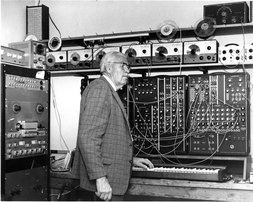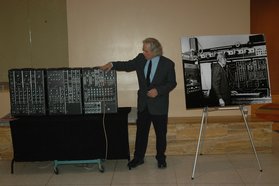A Tale of Two Cellos3/24/2014MARCH 24, 2014 “Our paths crossed several times over the years. I really admired him, and, hey – we both played cellos.  Born in 1892, John D. Robb was a New York City corporate attorney, but on the side he loved to sing and play the piano, guitar and cello. In 1941 he took a low paying job at the University of New Mexico as chairman of the Music Department and later was the first dean of the College of Fine Arts. Largely responsible for the growth and success of both divisions, he taught, composed, conducted, published albums and books and collected folk music. Before the age of computers, he pioneered electronic musical instruments and composed more than 65 electronic works – a path that Tom McVeety would later follow. McVeety grew up in Albuquerque, in the long shadow of Robb. He started playing cello about age 9. “The first memory I have of John Robb was a tall man with his cello coming to our house to play string quartets with my mother, Abigail, a violinist in the Albuquerque Civic Symphony. They were always friends. My mother had been a student of Laurent Halleaux, the second violinist of the Pro Arte Quartet, Rudolph Kolisch’s string quartet in the U.S. She received a master’s degree in music education at UNM in 1969,” said McVeety. “My four siblings and I all played musical instruments, and my mother taught private violin lessons at home. We were all in the Albuquerque Youth Symphony and the orchestras and bands of the public schools we attended. Youth Symphony meant Saturday mornings in the basement of the UNM Department of Music, learning symphonic music with AYS conductor and tireless youth music advocate, Dale Kempter.”  The path to electronic music began for Robb and McVeety in the 1950s and 1960s. Interested in the new medium, Robb attended a seminar hosted by Robert Moog, purchased a Moog synthesizer, started the Rio Grande Electronic Music Laboratory in his house and began composing electronic pieces. By the 1970s, the New Mexico Symphony Orchestra presented several Robb creations, including, “Space Odyssey West,” with Robb soloing on his Moog and projectors flashing colored lights on the walls of Popejoy Hall. McVeety’s interest in radio and electronics began early. “In grade school, I was listening to the electronic music available on short wave radios, usually described as radio static, environmental and manmade noises, and other phenomena. Especially interesting were the multi-path echoes from a single signal source propagating (circumnavigating) around the globe in both directions, but one arriving just before the other, giving an eerie electronic echo that I found fascinating,” he said. By the mid-1970s, McVeety was modifying an acoustic cello, adding a fifth string and a pickup, and composing his own music. Soon he designed a solid maple electric cello with six strings and built up a unique sound system using old and new technologies. As an undergraduate student at UNM, he learned to play viola da gamba and string bass and received three bachelor degrees – in cello performance, electrical engineering and music. He always saw Robb at the UNM Composer Symposium in the mid-1970s and again from 1980-1985. After graduating in 1985, Tom was on the road performing and doing some electronic technician work in Albuquerque. In the 1990s McVeety worked in the local electronic manufacturing industry, where he was awarded five patents in microwave filters – critical components in early cellular phone designs. His radio interests and musical training have been beneficial in his engineering career. The engineering jobs helped pay the bills but music was still his passion. McVeety has returned to UNM, where he is pursuing a master’s in composition. He also is the graduate assistant for the UNM Robb Musical Trust. He has studied composition and theory with Karola Obermüller, Peter Gilbert, Richard Hermann, David Bashwiner, William Wood, Chris Shultis and Scott Wilkinson, and acoustic cello with Joanna de Keyser and David Schepps. He has performed throughout the U.S. as a solo electric cellist and is a former member of several symphony and chamber orchestras, rock bands and early and new music ensembles. By the mid-1980s McVeety was performing with modern dancers in Boston and New York City. He was a frequent guest on the WNYC “New Sounds” radio show with John Schaefer, playing live on the air. He has played solo electric cello concerts in Merkin Hall at Lincoln Center and in the Cathedral of St. John the Divine. Back in Albuquerque, his shows in Keller Hall and the Kimo Theatre featured lights, slides and other visual projections done with his longtime collaborator, video artist Bob Crain. In late 1988, McVeety performed with Tim Wengert’s dance company and John Donald Robb attended, as did Tom’s parents. “Mom enjoyed catching up with John that night and hearing his comments about her son. That night I played a fairly long composition I had done for electric cello titled Blue Mesa. Tim's choreography was great. He had been Martha Graham's lead male dancer for many years in New York City,” said McVeety. “Around that time, I visited Robb’s home. We didn’t listen to anything, but I did get a tour of the house and the electronic studio and encouragement from a very gracious and interesting man. His lab was fascinating, as was his life. I never dreamed that one day I would be the Robb Graduate Assistant, working with the genius’ Moog, and his compositions and recordings at the Center for Southwest Research.” McVeety also helps with the UNM Composers’ Symposium, which this year takes place from April 5-10.  Robb died in 1989 but his memory lives on in musicians like McVeety, his archive and the Robb Trust. The John Donald Robb Musical Trust was established in 1989 by John D. and Harriet Robb to support the performance, study, promotion and dissemination of Robb's music and legacy, and to preserve the Robb Archive. The Robb Archive, housed in the UNM University Libraries, Center for Southwest Research and Special Collections (CSWR), contains Robb’s compositions, concert and folk recordings, papers, photos and the Trust’s performances. His folk recordings are online. The Robb Archive is also home to the musical recordings of more than 30 other Southwest collectors. McVeety has worked with film composer Mark Isham (The Beast of War, 1989), oud musician Rahim Alhaj (Baghdad Ensemble, 2007), flamenco dancer Eva Encinias-Sandoval and modern dancers Sarah Skaggs, Jim Coleman and Elinor Coleman. McVeety composed and performed the live solo acoustic cello music for Sarah Ruhl's "Melancholy Play," a 15-show production staged in fall 2008 by Tricklock Company and directed by Kevin Elder. One of his recent performances was April 2012 at the Domed Theater of the New Mexico Museum of Natural History, where he played his electric cello, using his computer-assisted signal-processing system. He followed that up with a performance in December 2012 at the museum’s Dyna Theater.  Last year McVeety repaired the power supply on Robb’s old Moog synthesizer and played it during the 2013 UNM John Donald Robb Composers’ Symposium. It was also featured in a fall concert that year. Plans continue to unfold for how to re-introduce Robb’s synthesizer as an educational tool at a time when there is a resurgence of interest in such analog-based electronic instruments. On Feb. 28, 2014, McVeety played a piece he composed for five-string cello and alto saxophone in Keller Hall for the UNM Composers’ Colloquium Spring concert series. In June he will perform on the electric cello in Santa Fe for Currents. What would John Donald Robb think of Abigail’s boy today? If it is a privilege for McVeety to work for the Robb Trust, what a boon it is for UNM to have such a talented innovative musician in our company. McVeety continues on the path inspired by Robb years ago. Both cellists had past careers but music dominated their lives. They both dared to follow their dreams, finding adventure, fulfilment and lasting value in music. By Nancy Brown Martinez, UNM University Libraries, Center for Southwest Research and Special Collections —Spring 2014 Comments are closed.
|
CATEGORIES
All
ARCHIVES
July 2024
|


 RSS Feed
RSS Feed